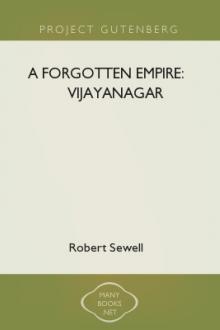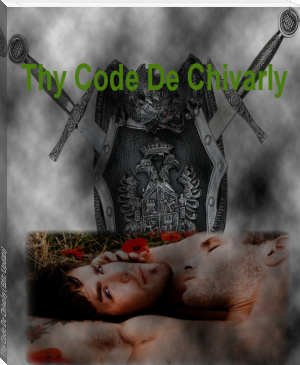A Forgotten Empire: Vijayanagar by Robert Sewell (short story to read TXT) 📕

- Author: Robert Sewell
- Performer: -
Book online «A Forgotten Empire: Vijayanagar by Robert Sewell (short story to read TXT) 📕». Author Robert Sewell
“Jaga Raya tried to evade this for some time; but finding that Echama Naique insisted, he decided to fight him, trusting that with so great a number of men he would easily not only be victorious, but would be able to capture both Echama Naique and the prince. He took the field, therefore, with all his troops. Echama Naique entrusted the prince to a force of ten thousand men who remained a league away, and with the other ten thousand he not only offered battle, but was the first to attack; and that with such fury and violence that Jaga Raya, with all the people surrounding his nephew, was driven to one side, leaving gaps open to the enemy, and many met their deaths in the fight. Echama Naique entered in triumph the tents of Jaga Raya, finding in them all the royal insignia belonging to the old King and these he delivered to the young prince, the Son of Chica Raya, proclaiming him rightful heir and King of all the empire of Bisnaga.
“The spoil which he took was very large, for in precious stones alone they say that he found two millions worth.
“After this victory many of the nobles joined themselves to Echama Naique. So much so, that in a short time he had with him fifty thousand fighting men in his camp; while Jaga Raya, with only fifteen thousand, fled to the jungles. Here, however, he was joined by more people, so that the war has continued these two years,[364] fortune favouring now one side now the other. But the party of the young prince has always been gaining strength; the more so because, although the great Naique of Madura365 — a page of the betel to the King of Bisnaga, who pays a revenue every year of, some say, 600,000 pagodas, and has under him many kings and nobles as vassals, such as he of Travancor — took the side of Jaga Raya, and sustained him against the Naique of Tanjaor. Yet the latter, though not so powerful, is, with the aid of the young King, gradually getting the upper hand. Indeed there are now assembled in the field in the large open plains of Trinchenepali366 not only the hundred thousand men that each party has, but as many as a million of soldiers.
“Taking advantage of these civil wars, the city of San Thome367 — which up to now belonged to the King of Bisnaga, paying him revenues and customs which he used to make over to certain chiefs, by whom the Portuguese were often greatly troubled determined to liberate itself, and become in everything and for everything the property of the King of Portugal. To this end she begged the Viceroy to send and take possession of her in the name of his Majesty, which he did, as I shall afterwards tell you. Meanwhile the captain who governed the town, by name Manuel de Frias, seeing that there was close to the town a fortress that commanded it, determined to seize it by force, seeing that its captain declined to surrender it. So he laid siege to it, surrounding it so closely that no one could get out.”
In the end the Portuguese were successful. The fortress was taken, its garrison of 1500 men capitulated, and a fleet came round by sea to complete the conquest.
The foregoing story relates to events never before, I think, made known to English readers, and so far is of the highest interest. Let us, for the moment, grant its accuracy, and read it by the light of the genealogical table already given.[368]
King Venkata I. (1586 — 1614) had a sister who was married to a chief whom Barradas calls “Obo” (perhaps Obala) Raya. So far as we know, his only nephews were Tirumala II. and Ranga III., sons of his brother, Rama III. Since Tirumala II. appears to have had no sons, and Ranga III. had a son, Rama IV, who is asserted in the inscriptions to have been “one of several brothers,” it is natural to suppose that the nephew mentioned by Barradas, who was raised to be king on the death of the old King Venkata I. in 1614, and who had three sons, was Ranga III., called “Chikka Raya” or “Crown-prince” in the text. He, then, succeeded in 1614, but was afterwards deposed, imprisoned, and compelled to take his own life. His eldest son at the same time followed his example, and his youngest son was slain by his father. The “middle son” escaped, and was raised to the throne by a friendly chief named Echama Naik. This second son was probably Ranga IV. Two of King Venkata’s wives were Bayama, daughter of Jaga Raya, and a lady unnamed, sister of Narpa Raya. A niece of Venkata I. had been given in marriage to a Brahman boy, who had been surreptitiously introduced into the palace by Bayama and educated in the pretence that he was son of King Venkata. The plot to raise him to the throne was temporarily successful, and Ranga III. and all the royal family were killed, saving only Ranga IV., who afterwards came to the throne.
How much of the story told is true we cannot as yet decide; but it is extremely improbable that the whole is a pure invention, and we may for the present accept it, fixing the date of these occurrences as certainly between the years 1614 and 1616 A.D. — the date of Barradas’s letter being December 12 in the latter year.
It will be observed that the inscriptions upon which the genealogical table given above, from the EPIGRAPHIA INDICA, is founded do not yield any date between A.D. 1614 and 1634, when Pedda Venkata II. is named as king. In 1883 I published369 a list of Vijayanagar names derived from reports of inscriptions which had then reached me. I am by no means certain of their accuracy, and it is clear that they must all be hereafter carefully examined. But so far as it goes the list runs thus: —
A.D. Ranga 1619 Rama 1620, 1622 Ranga 1623 Venkata 1623 Rama 1629 Venkata 1636The last-mentioned name and date are apparently correct.
In 1633 the Portuguese, encouraged by the Vijayanagar king, still at Chandragiri, attempted to eject the Dutch from “Paleacate,” or Pulicat. An arrangement was made by which the Portuguese were to attack by sea and the Rajah by land; but while the Viceroy sent his twelve ships as agreed on, the Rajah failed to attack, alleging in explanation that he was compelled to use his army to put down internal disturbances in the kingdom. A second expedition met with no better success, the plans of the Portuguese being again upset by the non fulfilment of the king’s part of the bargain. On the departure of the fleet the king did attack the Dutch settlement, but was bought off by a large payment, and the Hollanders remained subsequently undisturbed.
Senhor Lopes tells me that he has found in the National Archives in the Torre do Tombo, amongst the “Livros das Moncoes,” a number of papers bearing on this subject. The most interesting are those contained in Volume xxxiv. (fol. 91 — 99). These were written by the Captain-General of Meliapor (St. Thome), by Padre Pero Mexia of the Company of Jesus, and by the Bishop; and amongst the other documents are to be seen translations of two palm-leaf letters written by the king of Vijayanagar, then at Vellore. It appears from these that the king was devoid of energy, and that one Timma Raya had revolted against him.
We know that in 1639 the king of Vijayanagar was named Ranga or Sri-Ranga, and that he was at that time residing at Chandragiri; because in that year Mr. Day, the head of the English trading station a Madras, obtained from the king a grant of land at that place, one mile broad by five miles long, on which Fort St. George was afterwards constructed. The country about Madras was then ruled over by a governor or Naik, and so little heed did he pay to the wishes or commands of his titular sovereign, that although the Raya had directed that the name of the new town should be “Srirangarayalapatnam” (“city of Sri Ranga Raya”), the Naik christened it after the name of his own father, Chenna, and called it “Chennapatnam,” by which appellation it has ever since been known to the Hindus. Such, at least, is the local tradition. This king was probably the Ranga VI. of the Epigraphia list, mentioned as living in 1644 A.D.
After this date my (doubtful and unexamined) inscriptions yield the following names and dates: —
A.D. Ranga 1643, 1647, 1655, 1662, 1663, 1665, 1667, 1678 Venkata 1678, 1680 Ranga 1692 Venkata 1706 Ranga 1716 Mahadeva 1724 Ranga 1729 Venkata 1732 Rama 1739 (?) Venkata 1744 Venkata 1791, 1792, 1793From Sir Thomas Munro’s papers I gather that the territory about the old family estate of Anegundi was early in the eighteenth century held by the Rayas from the Mogul emperor of Delhi as a tributary state. In 1749 it was seized by the Mahrattas, and in 1775 it was reduced by Haidar Ali of Mysore, but continued to exist as a tributary quasi-independent state till the time of Tipu (Tippoo Sultan).
Tipu, who never suffered from an excess of compunction or compassion when his own interests were at stake, annexed the estate bodily to his dominions in 1786. Thirteen years later he was killed at Seringapatam, and in the settlement that followed the little territory was made over to the Nizam of Haidarabad, the English Government retaining all lands on their side of the Tungabhadra. Partly in compensation for this loss of land the Government has till very recently paid an annual pension to the head of the Anegundi family. This has now been abolished.
Chronicles of Paes and Nuniz
Letter
(? to the historian Barros) which accompanied the Chronicles when sent from India to Portugal about the year 1537 A.D.
Since I have lived till now in this city (? Goa), it seemed necessary to do what your Honour desired of me, namely, to search for men who had formerly been in Bisnaga; for I know that no one goes there without bringing away his quire of paper written about its affairs. Thus I obtained this summary from one Domingos Paes, who goes there, and who was at Bisnaga in the time of Crisnarao when Cristovao de Figueiredo was there. I obtained another from Fernao Nuniz, who was there three years trading in horses (which did not prove remunerative). Since one man cannot tell everything — one relating some things which another does not — I send both the summaries made by them, namely, one in the time of Crisnarao, as I have said, and the other sent from there six months since. I desire to do this because your honour can gather what is useful to you from both, and because you will thus give the more credit to some things in the chronicle of the kings of Bisnaga, since they conform one to the other. The copy of the summary which he began to make370 when he first went to the kingdom of Bisnaga is as follows: —
Narrative of Domingos Paes
(written probably A.D. 1520 — 22)
Of the things which I saw and contrived to learn concerning the kingdom of Narsimga, etc.[371]
On leaving India372 to travel towards the kingdom of Narsymga from the sea-coast, you have (first) to pass a range of hills (SERRA), the boundary of the said kingdom





Comments (0)